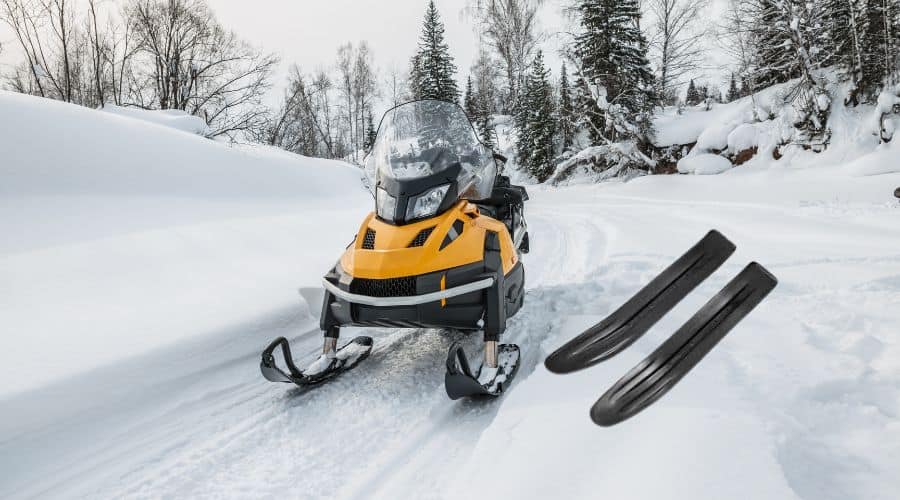Snowmobiles are the fastest and easiest way to traverse ice and snow quickly, but that speed equals wear and tear on your skis. Inspecting, maintaining, and replacing your skis regularly is essential, so you don’t waste fuel or worse.
A busted ski can leave you stranded far from home, but luckily you can protect them. What do snowmobile ski skins do?
Snowmobile ski skins go under the metal skis and create a layer between them and the ground to glide over the snow easier. A ski skin keeps the skis on your sled from sticking to snow and ice and prevents wear and damage as you ride. Ski skins are made from synthetic plastics.
Table of Contents
What Are Ski Skins For Snowmobiles
Ski skins attach to the underside of your snowmobile’s skis. These specially formed and fitted lengths of plastic are highly durable and smooth to protect your skis while offering a smoother, more efficient ride.
By providing a buffer between your sled and the ground, skins can help save you time and money.
Snowmobiles move fast and having a smooth under-ski surface helps them glide along snowy and icy surfaces, so you have better steering control.
Unfortunately, even on snow, the skis become worn down. Ski skins for snowmobiles are a simple, effective solution that keeps your skis intact by preventing them from touching the ground below.
According to NadaGuides, “The average highest speed for snowmobiles depends on the model but ranges around 95 miles per hour to 120 mph. Some of the higher speed snowmobiles can reach up to 150 miles per hour, but these are high power models.”
With all that speed, you can wear down a metal ski quickly, especially if you ride often.
What Are Ski Skins Made Of
Traditionally, ski skins were made for the skis people strap to their feet. They got the name because of the animal skin they were made from.
Providing a smooth buffer between expensive equipment and the ground below has always been a smarter way to move around quickly.
Modern ski skins are still available for classic skis but are also often used by savvy snowmobilers.
However, ski skins are not made from organic skin anymore. These days you’ll find skins made from UMHW or HDPE plastics because these modern materials are more durable and long-lasting than the original skins.
Plus, plastics offer an even smoother low-friction ride.
Are Snowmobile Ski Skins Worth It
Snowmobile ski skins are worth it. New skis for your sled will average you $100 to $500, but ski skins are generally in the $50 to $175 range.
Not only will they protect the metal, but skins offer an outstandingly smooth ride as you traverse the powder.
If a skin is damaged and interferes with your sled’s operation, you can remove it and finish the ride.
However, the same cannot be said of your skis. Moreover, ski skins often come in multipacks, so you get more for your money or as solo pieces when you only need a single side replacement.
How To Install Snowmobile Ski Skins
Installing snowmobile ski skins is a relatively straightforward experience. It’s important to check the size of your sled skis and get the correct fit.
Additionally, since these parts must be bolted on, you should look to see if your sled’s skis sport pre-drilled holes for this application.
Follow the steps below for easy installation of Snowmobile Ski Skins:
- Access the Skis – You can do both simultaneously with a jack or place a blanket on the floor and tip your sled so you can reach one side at a time. You can also remove the skis if you prefer.
- Check your skins and skis for pre-drilled holes to seat the skins.
- If you do not have pre-drilled holes that are too small or don’t match up, you’ll need to drill new holes. This is easier in plastic than in metal. However, avoid going too hard or fast as it can crack the plastic skin. You’ll need a special drill bit for working on metal.
- Once you have matching drill holes, secure the skis in place using a nut with a head that will sit flush. The bolt goes on top of the ski so the nut faces the snow; otherwise, it will dig in beneath you, causing danger to you and the sled as it drags and cuts a channel in the snow and ground below.
- Once the skis are installed, you can set your sled upright and ride whenever you’re ready.
Pro Tip: Some ski skins are made to snap over the metal of your skis. If you find this is the case, then there’s one easy trick to help you fit them on much more effortlessly. Get a large enough waterproof container to hold the skis inside when completely submerged. Next, fill it with hot, but not boiling, water. Leaving the plastic to soak and warm up for a few minutes will make it more pliable, and the application will be much easier. Don’t leave them sitting in the water too long, or they’ll cool off, and you will have to start over. You need to work with them while they are still hot, so wear gloves if necessary.
Best Snowmobile Ski Skins
- Made from 3/16″ thick polyethylene plastic
Last update on 2024-04-25 / Affiliate links / Images from Amazon Product Advertising API
I recommend the SnoStuff 501-201 Black Ski Skin from Amazon. These durable, 3/16-inch molded polyethylene plastic skins offer a custom look and easy installation with pre-drilled holes.
These skins are the same width as your skis to prevent friction and minimize weight while protecting your snowmobile skis from anything below.
These skis are highly rated and well-loved by sledders. One regular user says, “Great way to protect the older metal skis. Easy install; been installing them for folks for many years. A must if you have metal skis.”
Jason Says, “Great product to give new life to old beat-up skis”
Unlike some brands, Sno-Stuff sells skis in pairs, so you have everything you need to get out and ride.
You’ll appreciate their fast-shipping times and helpful customer service if you have any questions or concerns.
Get a set for your snowmobile by clicking right here.
Helpful Tips To Know About What Snowmobile Ski Skins Do
Using a ski skin on your snowmobile is an intelligent way to protect your skis. There are several other advantages as well, like giving your sled a custom appearance.
Here are more helpful tips to know about what snowmobile skis do.
- Ski skins are also made for regular skis that go on your feet, so pay careful attention when shopping for your sled. Always measure the size of your snowmobile skis and read the information before you purchase new skins. You can use fitted skins of the exact width to fit your skis or broader models for more grip, but do not install too-narrow skins as they will make the ski less stable and cause it to wear on the edges.
- Power Sports Guide states, “As a rule of thumb, snowmobile carbides last around 2,000-4,000 miles. Don’t forget that it depends on many factors like the design and quality of the carbides and where you regularly ride your sled. If you regularly ride on roads or roadsides, your carbides will only last 1,000 miles or even less!” Using skins will keep your skis intact for longer.
- Using ski skins makes your sled move smoothly over the snow. The friction on your skis typically slows you down and makes your snowmobile work harder to move. Thanks to a powerful engine, you may not notice the effect, but it’s happening regardless. Since the skis aren’t sticking and fighting the surface, you’ll get better fuel efficiency.
Final Thoughts
Ski skins were first used on traditional human-powered skis and got their name from the animal skin they were made out of.
However, modern ski skins are also made for snowmobiles and help protect the skis from damage.
Additionally, the contemporary plastic skins are more efficient at moving over snow and ice, so they can help reduce friction.
That means your engine doesn’t have to work so hard, so you save on gas. Installing ski skins is easy, fast, and well worth the effort for a better ride. Plus, skins cost far less than new skis.


